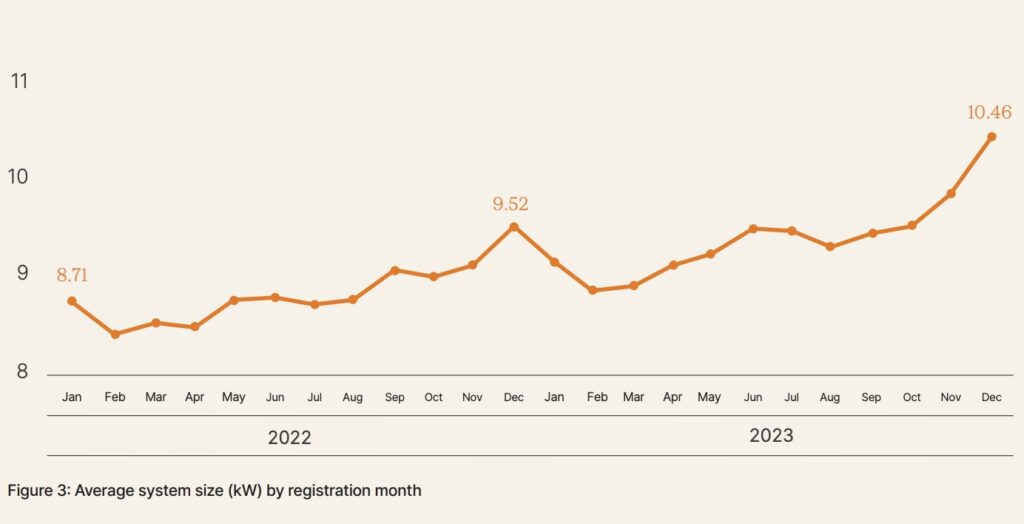Last update September 4th, 2024 at 08:52 pm
Solar energy has become increasingly popular as more homeowners and businesses look for sustainable ways to reduce their electricity bills. One of the most effective options is installing a 10-kilowatt (kW) solar system. This powerful setup is ideal for larger homes and small businesses that consume significant amounts of energy. In this guide, we will explore the costs, benefits, and considerations of investing in a 10kW solar system, helping you make an informed decision.

What is a 10kW Solar System?
A 10kW solar system consists of solar panels that can generate up to 10 kilowatts of power under optimal conditions. This system typically includes around 24 to 30 panels, depending on the efficiency and size of each panel and will require about 80m2 of roof space. With a 10kW system, it is possible to produce enough energy to cover the needs of a large household or a small business, especially if you live in a region with plenty of sunlight.
The Cost of a 10kW Solar System
One of the most crucial factors to consider when installing a solar system is the cost. In 2024, the price of a 10kW solar system in Australia can vary depending on several factors, including the brand of the panels, the quality of the inverter, and the installation fees. On average, you can expect to pay between $8,000 and $13,000 for a 10kW solar system.
1. Upfront Costs
The initial cost of the system includes the solar panels, inverter, mounting hardware, and installation labour. While the upfront investment may seem high, the long-term savings on your electricity bills can make it a worthwhile expense. Additionally, government incentives and rebates can significantly reduce the upfront cost.
2. Government Rebates
The Australian government offers several incentives to encourage the adoption of solar energy. The Small-scale Renewable Energy Scheme (SRES) provides a rebate in the form of Small-scale Technology Certificates (STCs). These certificates can be traded for cash or a discount on the system’s cost, potentially reducing the price by thousands of dollars.
3. Installation Costs
Installation costs can vary based on the complexity of the setup and the installer’s rates. It’s essential to get quotes from multiple installers to ensure you’re getting the best deal. Always choose an accredited installer to ensure quality workmanship and compliance with Australian standards.

Financial Benefits of a 10kW Solar System
Investing in a 10kW solar system can offer significant financial benefits over time. By generating your own electricity, you can drastically reduce or even eliminate your electricity bills. Here’s how:
1. Reduced Electricity Bills
A 10kW solar system can generate enough power to cover most, if not all, of the average Australian household’s energy needs. With the right system and optimal conditions, you can produce up to 40-50 kWh per day, depending on your location. This production can offset a substantial portion of your electricity consumption, leading to lower monthly bills.
2. Feed-in Tariffs
In addition to reducing your electricity bills, you can earn money by exporting excess energy back to the grid. Most Australian states offer feed-in tariffs, which pay you for the surplus energy your system generates. The rate varies by state and energy provider, but it can contribute significantly to your overall savings.
3. Return on Investment (ROI)
The return on investment for a 10kW solar system can be substantial. Depending on your location, energy usage, and feed-in tariff rates, you can expect to recoup your initial investment within 4 to 6 years. After that, the savings on your electricity bills will translate into pure profit.
Environmental Impact
Besides the financial benefits, installing a 10kW solar system also positively impacts the environment. By generating clean, renewable energy, you reduce your reliance on fossil fuels, thereby lowering your carbon footprint. Depending on your energy mix in your area, a 10kW system can offset around 15 to 20 tons of carbon dioxide emissions annually, making it an excellent choice for environmentally conscious individuals and businesses.
Considerations Before Installing a 10kW Solar System
Before investing in a 10kW solar system, it’s important to consider several factors:
- Roof Space: A 10kW system requires significant roof space, typically between 50 to 70 square meters. Ensure your roof can accommodate the panels and that it’s structurally sound.
- Energy Needs: Assess your current and future energy needs to determine if a 10kW system is the right size for you. If you plan to expand your home or add energy-intensive appliances, a larger system might be more appropriate.
- Orientation and Shading: The orientation and tilt of your solar panels will impact their efficiency. North-facing roofs in Australia receive the most sunlight. Additionally, avoid shading from trees or nearby buildings, as it can significantly reduce your system’s output.
- Battery Storage: Consider adding a battery storage system to maximise your solar investment. A battery allows you to store excess energy for use during the night or on cloudy days, increasing your energy independence and further reducing your reliance on the grid. As a result, a 10kW solar system with battery storage can sometimes be enough to eliminate a household’s power bills completely.
Conclusion
A 10kW solar system is a powerful and efficient way to reduce your energy costs and contribute to a greener future. Although the upfront investment may seem substantial, the long-term financial and environmental benefits make it a smart choice for larger households and small businesses. By carefully considering your energy needs, roof space, and installation options, you can maximise the return on your investment and enjoy the many advantages of solar power.
If you’re ready to take the next step, contact an accredited solar installer to get a tailored quote and start your journey toward energy independence.